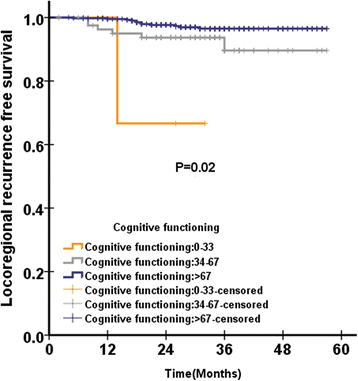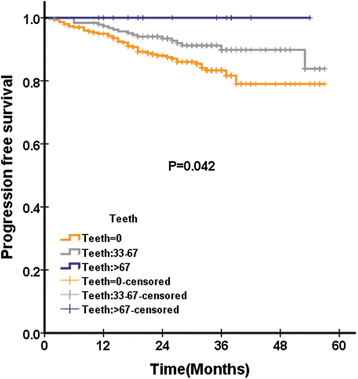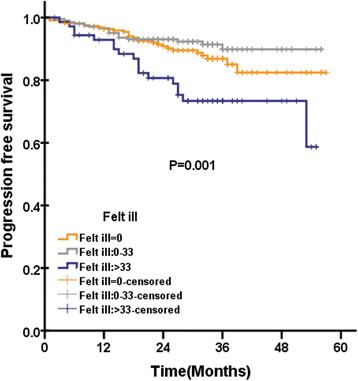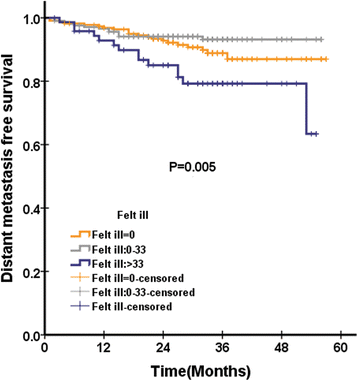Pretreatment quality of life as a predictor of survival for patients with nasopharyngeal carcinoma treated with IMRT
- PMID: 29386004
- PMCID: PMC5793429
- DOI: 10.1186/s12885-018-4003-8
Pretreatment quality of life as a predictor of survival for patients with nasopharyngeal carcinoma treated with IMRT
Abstract
Background: To evaluate the prognostic significance of pretreatment quality of life for patients with nasopharyngeal carcinoma treated with intensity-modulated radiotherapy.
Methods: We performed a prospective, longitudinal study on 554 newly diagnosed patients with NPC from April 2011 to January 2015. A total of 501 consecutive NPC patients were included. Patients were asked to complete the EORTC QLQ-C30 (version 3.0) and QLQ-H&N35 questionnaires before treatment.
Results: Global health status among QLQ-C30 correlates with EBV DNA(P = 0.019). In addition, pretreatment appetite loss was significantly correlated with EBV DNA(P = 0.02). Pretreatment teeth, opening mouth, feeding tube was significantly correlated with EBV DNA, with P value of 0.003, < 0.0001, and 0.031, respectively. In multivariate analysis, pretreatment cognitive functioning of QLQ-C30 was significantly associated with LRFS, with HR of 0.971(95%CI 0.951-0.990), P = 0.004. Among scales of QLQ-H&N35 for multivariate analysis, pretreatment teeth (P = 0.026) and felt ill (P = 0.012) was significantly associated with PFS, with HR of 0.984 (95%CI 0.971-.998) and 1.004 (95%CI 1.001-1.007), respectively. Felt ill of QLQ-H&N35 was significantly associated with DMFS, with HR of 1.004(95%CI 1.000-1.007), P = 0.043. There is no QoL scale significantly associated with OS after multivariate analysis.
Conclusions: In conclusion, our analysis confirms that pretreatment teeth and felt ill was significantly associated with PFS in NPC patients treated with IMRT. In addition, the posttreatment EBV DNA was significantly associated with OS.
Keywords: EBV DNA; Nasopharyngeal carcinoma; Prognostic factor; Quality of life; Survival.
Conflict of interest statement
Ethics approval and consent to participate
This study was approved by the clinical research ethics committee of the Sun Yat-Sen University Cancer Center(B2011–004-01), and the participants provided written informed consent.
Consent for publication
Not applicable.
Competing interests
The authors declare that they have no competing interests.
Publisher’s Note
Springer Nature remains neutral with regard to jurisdictional claims in published maps and institutional affiliations.
Figures




Similar articles
-
Long-term late toxicities and quality of life for survivors of nasopharyngeal carcinoma treated with intensity-modulated radiotherapy versus non-intensity-modulated radiotherapy.Head Neck. 2016 Apr;38 Suppl 1:E1026-32. doi: 10.1002/hed.24150. Epub 2015 Jul 18. Head Neck. 2016. PMID: 26041548
-
Outcomes of xerostomia-related quality of life for nasopharyngeal carcinoma treated by IMRT: based on the EORTC QLQ-C30 and H&N35 questionnaires.Expert Rev Anticancer Ther. 2015 Jan;15(1):109-19. doi: 10.1586/14737140.2015.961427. Epub 2014 Sep 18. Expert Rev Anticancer Ther. 2015. PMID: 25231774 Review.
-
Plasma Epstein-Barr viral DNA complements TNM classification of nasopharyngeal carcinoma in the era of intensity-modulated radiotherapy.Oncotarget. 2016 Feb 2;7(5):6221-30. doi: 10.18632/oncotarget.6754. Oncotarget. 2016. PMID: 26716900 Free PMC article.
-
Pretreatment prognostic factors of survival and late toxicities for patients with nasopharyngeal carcinoma treated by simultaneous integrated boost intensity-modulated radiotherapy.Radiat Oncol. 2018 Mar 20;13(1):45. doi: 10.1186/s13014-018-0990-5. Radiat Oncol. 2018. PMID: 29554940 Free PMC article.
-
AHNS Series - Do you know your guidelines? Principles of treatment for nasopharyngeal cancer: A review of the National Comprehensive Cancer Network guidelines.Head Neck. 2017 Feb;39(2):201-205. doi: 10.1002/hed.24635. Epub 2016 Nov 29. Head Neck. 2017. PMID: 27898198 Review.
Cited by
-
Comparison of long-term quality of life and their predictors in survivors between paediatric and adult nasopharyngeal carcinoma in the intensity-modulated radiotherapy era.BMC Cancer. 2024 Oct 2;24(1):1223. doi: 10.1186/s12885-024-12966-4. BMC Cancer. 2024. PMID: 39358733 Free PMC article.
-
Joint modeling of longitudinal health-related quality of life during concurrent chemoradiotherapy period and long-term survival among patients with advanced nasopharyngeal carcinoma.Radiat Oncol. 2024 Sep 20;19(1):125. doi: 10.1186/s13014-024-02473-y. Radiat Oncol. 2024. PMID: 39304905 Free PMC article.
-
Longitudinal Trend of Health-Related Quality of Life During Concurrent Chemoradiotherapy and Survival in Patients With Stage II-IVb Nasopharyngeal Carcinoma.Front Oncol. 2020 Oct 8;10:579292. doi: 10.3389/fonc.2020.579292. eCollection 2020. Front Oncol. 2020. PMID: 33134176 Free PMC article.
-
Predictors of survival among head and neck cancer patients after radiotherapy based on health-related quality of life indices and symptoms-specific outcomes: a systematic review.Qual Life Res. 2025 Apr 11. doi: 10.1007/s11136-025-03933-y. Online ahead of print. Qual Life Res. 2025. PMID: 40214872 Review.
-
Identification of potential long noncoding RNA associated with nasopharyngeal carcinoma using deep sequencing.J Int Med Res. 2019 Jul;47(7):3271-3281. doi: 10.1177/0300060519845973. Epub 2019 May 24. J Int Med Res. 2019. PMID: 31122165 Free PMC article.
References
-
- Wang R, Wu F, Lu H, Wei B, Feng G, Li G, Liu M, Yan H, Zhu J, Zhang Y, et al. Definitive intensity-modulated radiation therapy for nasopharyngeal carcinoma: long-term outcome of a multicenter prospective study. J Cancer Res Clin Oncol. 2013;139(1):139–145. doi: 10.1007/s00432-012-1313-0. - DOI - PMC - PubMed
-
- Chen L, Hu CS, Chen XZ, Hu GQ, Cheng ZB, Sun Y, Li WX, Chen YY, Xie FY, Liang SB, et al. Concurrent chemoradiotherapy plus adjuvant chemotherapy versus concurrent chemoradiotherapy alone in patients with locoregionally advanced nasopharyngeal carcinoma: a phase 3 multicentre randomised controlled trial. Lancet Oncol. 2012;13(2):163–171. doi: 10.1016/S1470-2045(11)70320-5. - DOI - PubMed
Publication types
MeSH terms
Grants and funding
- 81425018/National Natural Science Foundation of China/International
- 81072226/National Natural Science Foundation of China/International
- 81201629/National Natural Science Foundation of China/International
- 2012AA02A501/the 863 Project/International
- 2013CB910304/National Key Basic Research Program of China/International
- 2014TX01R145/Special Support Plan of Guangdong Province/International
- No.2014A020212103, No.2011B080701034, No.2011B031800161/Sci-Tech Project Foundation of Guangdong Province/International
- 201400000001/Health & Medical Collaborative Innovation Project of Guangzhou City/International
- 2014BAI09B10/National Science & Technology Pillar Program during the Twelfth Five-year Plan Period/International
- A2014252/the Medical Research Foundation of Guangdong Province/International
LinkOut - more resources
Full Text Sources
Other Literature Sources
Miscellaneous

